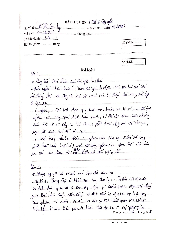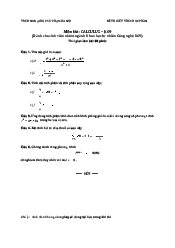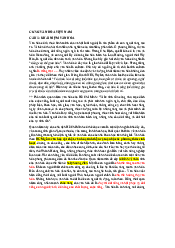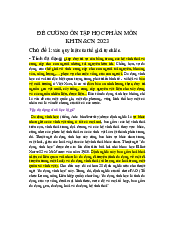




Preview text:
IMO Training 2010 Projective Geometry - Part 2 Alexander Remorov Projective Geometry - Part 2 Alexander Remorov alexanderrem@gmail.com Review −→ − − →
• Four collinear points A, B, C, D form a harmonic bundle (A, C; B, D) when CA DA − − → : − − → = −1. C B DB
• A pencil P (A, B, C, D) is the set of four lines P A, P B, P C, P D. It is harmonic iff (A, B; C, D)
is harmonic. Intersecting a harmonic pencil with any line produces a harmonic bundle.
• In △ABC, points D, E, F are on sides BC, CA, AB. Let F E intersect BC at G. Then
(B, C; D, G) is harmonic iff AD, BE, CF are concurrent.
• A point P is outside or on a circle ω. Let P C, P D be tangents to ω, and l be a line through
P intersecting ω at A, B (so that P, A, B are collinear in this order). Let AB intersect CD at
Q. Then ACBD is a harmonic quadrilateral (i.e. AC = AD ) and (P, Q; A, B) is harmonic. C B DB
• Points A, C, B, D lie on a line in this order, and M is the midpoint of CD. Then (A, B; C, D)
is harmonic iff AC · AD = AB · AM . Furthermore, if (A, B; C, D) is harmonic then M D2 = M A · M B.
• Points A, C, B, D lie on a line in this order. P is a point not on on this line. Then any two
of the following conditions imply the third: 1. (A, B; C, D) is harmonic.
2. P B is the angle bisector of ∠CP D. 3. AP ⊥ P B.
• Given a circle ω with center O and radius r and any point A 6= O. Let A′ be the point on
ray OA such that OA · OA′ = r2. The line l through A′ perpendicular to OA is called the
polar of A with respect to ω. A is called the pole of l with respect to ω.
• Consider a circle ω and a point P outside it. Let P C and P D be the tangents from P to ω.
Then ST is the polar of P with respect to ω.
• La Hire’s Theorem: A point X lies on the polar of a point Y with respect to a circle ω.
Then Y lies on the polar of X with respect to ω.
• Brokard’s Theorem: The points A, B, C, D lie in this order on a circle ω with center O.
AC and BD intersect at P , AB and DC intersect at Q, AD and BC intersect at R. Then O
is the orthocenter of △P QR. Furthermore, QR is the polar of P , P Q is the polar of R, and
P R is the polar of Q with respect to ω.
• M is the midpoint of a line segment AB. Let P
be a point at infinity on line AB. Then ∞ (M, P ; A, B) is harmonic. ∞ 1 IMO Training 2010 Projective Geometry - Part 2 Alexander Remorov Heavy Machinery
• For a point P and a circle ω with center O, radius r, define the power of a point P with
respect to ω by d(P, ω) = P O2 − r2. For two circles ω1, ω2 there exists a unique line l, called
the radical axis, such that the powers of any point on this line with respect to ω1, ω2 are
equal. In particular, if ω1 ∩ ω2 = {P, Q} then line P Q is the radical axis of ω1, ω2.
Radical Axis Theorem: Given three circles ω1, ω2, ω3, let l, m, n be the radical axes of
ω1, ω2; ω1, ω3; ω2, ω3 respectively. Then l, m, n are concurrent at a point called the radical centre of the three circles.
• Pascal’s Theorem: Given a hexagon ABCDEF inscribed in a circle, let P = AB∩ED, Q =
BC ∩ EF, R = CD ∩ AF . Then P, Q, R are collinear. (An easy way to remember - the three
points of intersection of pairs of opposite sides are collinear).
Note: Points A, B, C, D, E, F do not have to lie on the circle in this order.
Note: It is sometimes useful to use degenerate versions of Pascal’s Theorem. For example if
C ≡ D then line CD becomes the tangent to the circle at C.
• Brianchon’s Theorem: Given a hexagon ABCDEF circumscribed about a circle, the three
diagonals joining pairs of opposite points are concurrent, i.e. AD, BE, CF are concurrent.
Note: It is sometimes useful to use degenerate versions of Brianchon’s Theorem. For example
if ABCD is a quadrilateral circumscribed about a circle tangent to BC, AD at P, Q then P Q, AC, BD are concurrent.
• Desargues’ Theorem: Given two triangles A1B1C1 and A2B2C2 we say that they are
perspective with respect to a point when A1A2, B1B2, C1C2 are concurrent. We say that they
are perspective with respect to a line when A1B1 ∩ A2B2, A1C1 ∩ A2C2, C1B1 ∩ C2B2 are
collinear. Then two triangles are perspective with respect to a point iff they are perspective with respect to a line.
• Sawayama-Thebault’s Theorem: A point D is on side BC of △ABC. A circle ω1 with
centre O1 is tangent to AD, BD and Γ, the circumcircle of △ABC. A circle ω2 with centre O2
is tangent to AD, DC and Γ. Let I be the incentre of △ABC. Then O1, I, O2 are collinear.
It is unlikely that a problem using this theorem will come up on IMO, however it is a nice
result and is a good exercise to prove. See problem 5. Homothety
Looking at geometric configurations in terms of various geometric transformations often offers great
insight in the problem. You should be able to recognize configurations where transformations can
be applied, such as homothety, reflections, spiral similarities, and projective transformations. To-
day we will be focusing on homothety. The powerful thing about homothety is that it preserves angles and tangency.
Consider two circles ω1, ω2 with centres O1, O2. There are two unique points P, Q, such that a
homothety with centre P and positive coefficient carries ω1 to ω2, and a a homothety with centre
Q and negative coefficient carries ω1 to ω2. P is called the exsimilicentre, and Q is called the
insimilicentre of ω1, ω2. Some useful facts: 2 IMO Training 2010 Projective Geometry - Part 2 Alexander Remorov
1. P is the intersection of external tangents to ω1, ω2. Q is the intersection of internal tangents to ω1, ω2.
2. Let ω1, ω2 intersect at S, R; P A1, P A2 are tangents to ω1, ω2 so that A1, A2 are on the same
side of O1O2 as S. Then P R is tangent to the circumcircle of △A1RA2. 3. (P, R; O1, O2) is harmonic.
4. Monge’s Theorem: Given three circles ω1, ω2, ω3. Then the exsimilicentres of ω1 and ω2,
of ω1 and ω3, and of ω2 and ω3 are collinear.
Proof : Let O1, O2, O3 be the centres of the circles. Let K1 be the intersection of the common
tangents of ω1, ω2 and ω1, ω3. Define K2, K3 similarly. Then KiAi is the angle bisector of ∠Ki
in △K1K2K3. Hence K1A1, K2A2, K3A3 are concurrent. The result follows by Desargues’ theorem.
A proof without using Desargues’ theorem: let X3 be the exsimilicentre of ω1, ω2; define
X1, X2 similarly. Apply Menelaus Theorem to △X1X2O3.
5. Monge-d’Alembert Theorem: Given three circles ω1, ω2, ω3. Then the exsimilicentre of
ω1, ω2, the insimilicentre of ω1, ω3 and the insimilicentre of ω2, ω3 are collinear.
Proof : Let O1, O2, O3 be the centres of the circles; X3 be the exsimilicentre of ω1, ω2; define
X1, X2 similarly. Apply Menelaus Theorem to △O1O2O3. Problems
Some of these problems are lemmas from Yufei Zhao’s handout on Lemmas in Eucledian Geometry.
The lemmas cannot be quoted on a math contest, so make sure to know their proofs!
1. The incircle ω of △ABC has centre I and touches BC at D. DE is the diameter of ω. If AE
intersects BC at F , prove that BD = F C.
2. The incircle of △ABC touches BC at E. AD is the altitude in △ABC; M is the midpoint of
AD. Let Ia be the centre of the excircle opposite to A of △ABC. Prove that M, E, Ia are collinear.
3. A circle ω is internally tangent to a circle Γ at P . A and B are points on Γ such that AB is
tangent to ω at K. Show that P K bisects the arc AB not containing point P .
4. Let Γ be the circumcircle of △ABC and D an arbitrary point on side BC. The circle ω is
tangent to AD, DC, Γ at F, E, K respectively. Prove that the increntre I of △ABC lies on EF .
5. Prove the Sawayama-Thebault’s Theorem.
6. Γ is the circumcircle of △ABC. The incircle ω is tangent to BC, CA, AB at D, E, F respectively.
A circle ωA is tangent to BC at D and to Γ at A′, so that A′ and A are on different sides of BC.
Define B′, C′ similarly. Prove that DA′, EB′, F C′ are concurrent.
7. (Romania TST 2004) The incicrle of a non-isosceles △ABC is tangent to sies BC, CA, AB at
A′, B′, C′. Lines AA′, BB′ intersect at P , AC and A′C′ at M , and lines B′C′ and BC at N . Prove that IP ⊥ M N . 3 IMO Training 2010 Projective Geometry - Part 2 Alexander Remorov
These are very non-trivial problems; the last few are very hard.
8. (Iran TST 2007) The incircle ω of △ABC is tangent to AC, AB at E, F respectively. Points
P, Q are on AB, AC such that P Q is parallel to BC and is tangent to ω. Prove that if M is the
midpoint of P Q, and T the intersection point of EF and BC, then T M is tangent to ω.
9. (Romania TST 2007) The incircle ω of △ABC is tangent to AB, AC at F, E respectively. M
is the midpoint of BC and N is the intersection of AM and EF . A circle Γ with diameter BC
intersects BI, CI at X, Y respectively. Prove that NX = AC . N Y AB
10. (Romania TST 2007) ωa, ωb, ωc are circles inside △ABC, that are tangent (externally) to each
other, and ωa is tangent to AB and AC, ωb is tangent to BA and BC, and ωc is tangent to CA
and CB. Let D be the common point of ωb and ωc, E the common point of ωc and ωa, and F the
common point of ωa and ωb. Show that AD, BE, CF are concurrent.
11. (Romania TST 2006) Let ABC be an acute triangle with AB 6= AC. Let D be the foot of the
altitude from A and Γ the circumcircle of the triangle. Let ω1 be the circle tangent to AD, BD and
Γ. Let ω2 be the circle tangent to AD, CD and Γ. Let l be the interior common tangent to both ω1
and ω2, different from AD. Prove that l passes through the midpoint of BC iff AB + AC = 2BC.
12. (China TST 2006 Generalized) In a cyclic quadrilateral ABCD circumscribed about a cir-
cle with centre O, the diagonals AC, BD intersect at E. P is an arbitrary point inside ABCD
and X, Y, Z, W are the circumcentres of triangles ABP, BCP, CDP, DAP respectively. Show that XZ, Y W, OE are concurrent.
13. (Iran TST 2009) The incircle of △ABC is tangent to BC, CA, AB at D, E, F respectively.
Let M be the foot of the perpendicular from D to EF and P be the midpoint of DM . If H is the
orthocenter of △BIC, prove that P H bisects EF .
14. (SL 2007 G8) Point P lies on side AB of a convex quadrilateral ABCD. Let ω be the incircle
of △CP D, and let I be its incenter. Suppose that ω is tangent to the incircles of triangles AP D
and BP C at points K and L, respectively. The lines AC and BD meet at E, and let lines AK and
BL meet at F . Prove that points E, I, and F are collinear.
15. (SL 2008 G7) Let ABCD be a convex quadrilateral with BA 6= BC. Denote the incircles of
△ABC and △ADC by k1 and k2 respectively. Suppose that there exists a circle k tangent to lines
AD, CD, to ray BA beyond A and to the ray BC beyond C. Prove that the common external
tangents to k1 and k2 intersect on k.
16. (Iran TST 2010) Circles ω1, ω2 intersect at P, K. Points X, Y are on ω1, ω2 respectively so
that XY is tangent externally to both circles and XY is closer to P than K. XP intersects ω2
for the second time at C and Y P intersects ω1 for the second time at B. BX and CY intersect
at A. Prove that if Q is the second intersection point of circumcircles of △ABC and △AXY then ∠QXA = ∠QKP . 4 IMO Training 2010 Projective Geometry - Part 2 Alexander Remorov Hints 1-3. Straightforward.
4. Extend KE to meet Γ at M . What can you say about A, I, M ?
5. Use problem 4. What can you say about ∠O1DO2?
6. Lots of circles and points of tangency... Which theorem to use? 7. Poles and Polars are BACK.
8. Let ω be tangent to BC at D. Let S be the point of intersection of AD with ω. What can you
say about the relation between T and AD with respect to ω? 9. Prove that X, Y lie on EF .
10. Draw the centres of the circles. Which theorem(s) should you be using here?
11. It is obvious which theorem to use here. What can you say about O1, D, M, O2?
12. Let M be the point of intersection of circumcircles of △BP C, △AP D and N the point of
intersection of circumcircles of △BP A, △CP D. Consider the circumcentre of △P N M. 13. Harmonic division.
14. Consider the circle tangent to AB, BC, DA. Find two more circles. Again lots of circles...
15. Let ω1, ω2 be tangent to AC at J, L. Prove that AJ = CL. Draw some excircles. Draw some lines parallel to AC.
16. This is a hard and beautiful problem. Let O be the intersection of AQ and XY . We want to
use the radical axis theorem... Where is the third circle? References
1 Yufei Zhao, Lemmas in Euclidean Geometry,
http://web.mit.edu/yufeiz/www/geolemmas.pdf
2 Various MathLinks Forum Posts; in particular posts by Cosmin Pohoata and luisgeometria,
http://www.artofproblemsolving.com/Forum/index.php 5




